All-Atomic Molecular Dynamic Studies of Human and Drosophila CDK8: Insights into Their Kinase Domains, the LXXLL Motifs, and Drug Binding Site
Abstract
1. Introduction
2. Results
2.1. The LXXLL Motif of CDK8 is Required for CDK8 to Regulate the Timing of Pupariation
2.2. The Kinase Activity of CDK8 is Required for Its Regulation of the Timing of Pupariation
2.3. Generation of Theoretical Structures of Drosophila CDK8 and the Mutations of Human and Drosophila CDK8
2.4. Analyses of the Potential Energy, Hydrogen Bond, RMSD and Global Structure of CDK8
2.5. The Analyses of the Hydrogen Bond Occupation between Leu312, Leu315 and Leu316 in the LXXLL Motifs of hCDK8 and dCDK8
2.6. The Differences in the Pattern of Hydrogen Bonds between Leu312, Leu315 and Leu316 in the LXXLL Motifs of CDK8 Proteins
2.7. The Specific Geometry of the Triangle Formed from Cα Atoms of Three Leucine Residues in the LXXLL Motif
2.8. The Differences in Hydrogen Bond Occupation and the Effect of CDK8 Mutations on the Hydrogen Bonds between His149 and Asp151, and Between Asp151 and Asn156
2.9. The Effect of hCDK8/dCDK8 Mutations on Hydrogen Bonds between P154 and I157 and Geometry of Triangles Formed from Cα Atoms of P(L)154, I157 and D173
2.10. The Clustering Result Shows the Difference between hCDK8 and dCDK8 Structures
2.11. The Substructure Specifically Belonging to hCDK8 with BAX Was Identified
3. Discussion
4. Materials and Methods
4.1. Drosophila Stocks and Reagents
4.2. Validation of cdk8 Mutant and Rescued Line
4.3. Generation of dCDK8 Leucine-Rich Motif Mutant Allele cdk8AQKAA-EGFP
4.4. Analyses of the Timing for the Larval-Pupal Transition and Western Blots
4.5. Molecular Modeling of Human and Fly CDK8
4.6. Molecular Dynamics (MD) Simulations of Human and Fly CDK8 with Their Point Mutations Using the Amber Package
4.7. Structure Comparison of Human and Drosophila CDK8 and Their Mutations
4.8. Build of the BAX Prmtop and Inpcrd Files Using the Gaussian 09 and Amber Software Packages
Supplementary Materials
Author Contributions
Funding
Acknowledgments
Conflicts of Interest
References
- Kornberg, R.D. Mediator and the mechanism of transcriptional activation. Trends Biochem. Sci. 2005, 30, 235–239. [Google Scholar] [CrossRef] [PubMed]
- Bourbon, H.-M.; Aguilera, A.; Ansari, A.Z.; Asturias, F.J.; Berk, A.J.; Björklund, S.; Blackwell, T.; Borggrefe, T.; Carey, M.F.; Carlson, M.; et al. A Unified Nomenclature for Protein Subunits of Mediator Complexes Linking Transcriptional Regulators to RNA Polymerase II. Mol. Cell 2004, 14, 553–557. [Google Scholar] [CrossRef] [PubMed]
- Conaway, R.C.; Conaway, J.W. Function and regulation of the Mediator complex. Curr. Opin. Genet. Dev. 2011, 21, 225–230. [Google Scholar] [CrossRef] [PubMed]
- Poss, Z.C.; Ebmeier, C.C.; Taatjes, D.J. The Mediator complex and transcription regulation. Crit. Rev. Biochem. Mol. Biol. 2013, 48, 575–608. [Google Scholar] [CrossRef] [PubMed]
- Tsai, K.L.; Sato, S.; Tomomori-Sato, C.; Conaway, R.C.; Conaway, J.W.; Asturias, F.J. A conserved Mediator-CDK8 kinase module association regulates Mediator-RNA polymerase II interaction. Nat. Struct. Mol. Biol. 2013, 20, 611–619. [Google Scholar] [CrossRef] [PubMed]
- Malik, S.; Roeder, R.G. Dynamic regulation of pol II transcription by the mammalian Mediator complex. Trends Biochem. Sci. 2005, 30, 256–263. [Google Scholar] [CrossRef]
- Morris, E.J.; Ji, J.Y.; Yang, F.; Di Stefano, L.; Herr, A.; Moon, N.S.; Kwon, E.J.; Haigis, K.M.; Naar, A.M.; Dyson, N.J. E2F1 represses beta-catenin transcription and is antagonized by both pRB and CDK. Nature 2008, 455, 552–556. [Google Scholar] [CrossRef]
- Zhao, J.; Ramos, R.; Demma, M. CDK8 regulates E2F1 transcriptional activity through S375 phosphorylation. Oncogene 2012, 32, 3520–3530. [Google Scholar] [CrossRef]
- Fryer, C.J.; White, J.; Jones, K.A. Mastermind Recruits CycC:CDK8 to Phosphorylate the Notch ICD and Coordinate Activation with Turnover. Mol. Cell 2004, 16, 509–520. [Google Scholar] [CrossRef]
- Donner, A.J.; Szostek, S.; Hoover, J.M.; Espinosa, J.M. CDK8 Is a Stimulus-Specific Positive Coregulator of p53 Target Genes. Mol. Cell 2007, 27, 121–133. [Google Scholar] [CrossRef]
- Alarcon, C.; Zaromytidou, A.I.; Xi, Q.; Gao, S.; Yu, J.; Fujisawa, S.; Barlas, A.; Miller, A.N.; Manova-Todorova, K.; Macias, M.J.; et al. Nuclear CDKs drive Smad transcriptional activation and turnover in BMP and TGF-beta pathways. Cell 2009, 139, 757–769. [Google Scholar] [CrossRef] [PubMed]
- Aleman, A.; Rios, M.; Juarez, M.; Lee, D.; Chen, A.; Eivers, E. Mad linker phosphorylations control the intensity and range of the BMP-activity gradient in developing Drosophila tissues. Sci. Rep. 2014, 4, 6927. [Google Scholar] [CrossRef] [PubMed]
- Zhao, X.; Feng, D.; Wang, Q.; Abdulla, A.; Xie, X.-J.; Zhou, J.; Sun, Y.; Yang, E.S.; Liu, L.-P.; Vaitheesvaran, B.; et al. Regulation of lipogenesis by cyclin-dependent kinase 8-mediated control of SREBP-1. J. Clin. Investig. 2012, 122, 2417–2427. [Google Scholar] [CrossRef]
- Bancerek, J.; Poss, Z.C.; Steinparzer, I.; Sedlyarov, V.; Pfaffenwimmer, T.; Mikulic, I.; Dölken, L.; Strobl, B.; Müller, M.; Taatjes, D.J.; et al. CDK8 Kinase Phosphorylates Transcription Factor STAT1 to Selectively Regulate the Interferon Response. Immunology 2013, 38, 250–262. [Google Scholar] [CrossRef] [PubMed]
- Fant, C.B.; Taatjes, D.J. Regulatory functions of the Mediator kinases CDK8 and CDK. Transcription 2019, 10, 76–90. [Google Scholar] [CrossRef]
- Li, X.; Liu, M.; Ji, J.-Y. Understanding Obesity as a Risk Factor for Uterine Tumors Using Drosophila. Adv. Exp. Med. Biol. 2019, 1167, 129–155. [Google Scholar] [CrossRef]
- Firestein, R.; Shima, K.; Nosho, K.; Irahara, N.; Baba, Y.; Bojarski, E.; Giovannucci, E.L.; Hahn, W.C.; Fuchs, C.S.; Ogino, S. CDK8 expression in 470 colorectal cancers in relation to β-catenin activation, other molecular alterations and patient survival. Cancer Genet. 2010, 126, 2863–2873. [Google Scholar] [CrossRef]
- Greenman, C.; Stephens, P.; Smith, R.; Dalgliesh, G.L.; Hunter, C.; Bignell, G.; Davies, H.; Teague, J.; Butler, A.; Stevens, C.; et al. Patterns of somatic mutation in human cancer genomes. Nature 2007, 446, 153–158. [Google Scholar] [CrossRef]
- Xu, W.; Ji, J.-Y. Dysregulation of CDK8 and Cyclin C in tumorigenesis. J. Genet. Genom. 2011, 38, 439–452. [Google Scholar] [CrossRef]
- Clark, A.D.; Oldenbroek, M.; Boyer, T.G. Mediator kinase module and human tumorigenesis. Crit. Rev. Biochem. Mol. Boil. 2015, 50, 393–426. [Google Scholar] [CrossRef]
- Xie, X.-J.; Hsu, F.-N.; Gao, X.; Xu, W.; Ni, J.-Q.; Xing, Y.; Huang, L.; Hsiao, H.-C.; Zheng, H.; Wang, C.; et al. CDK8-Cyclin C Mediates Nutritional Regulation of Developmental Transitions through the Ecdysone Receptor in Drosophila. Plos Boil. 2015, 13, e1002207. [Google Scholar] [CrossRef]
- Gao, X.; Xie, X.-J.; Hsu, F.-N.; Li, X.; Liu, M.; Hemba-Waduge, R.-U.-S.; Xu, W.; Ji, J.-Y. CDK8 mediates the dietary effects on developmental transition in Drosophila. Dev. Boil. 2018, 444, 62–70. [Google Scholar] [CrossRef]
- Belakavadi, M.; Fondell, J.D. Role of the mediator complex in nuclear hormone receptor signaling. Rev. Physiol. Biochem. Pharmacol. 2006, 156, 23–43. [Google Scholar] [PubMed]
- Berger, J.; Senti, K.-A.; Senti, G.; Newsome, T.P.; Åsling, B.; Dickson, B.J.; Suzuki, T. Systematic Identification of Genes that Regulate Neuronal Wiring in the Drosophila Visual System. PLOS Genet. 2008, 4, e1000085. [Google Scholar] [CrossRef]
- Zwier, M.C.; Chong, L.T. Reaching biological timescales with all-atom molecular dynamics simulations. Curr Opin. Pharmacol 2010, 10, 745–752. [Google Scholar] [CrossRef] [PubMed]
- Xu, W.; Amire-Brahimi, B.; Xie, X.-J.; Huang, L.; Ji, J.-Y. All-atomic Molecular Dynamic Studies of Human CDK8: Insight into the A-loop, Point Mutations and Binding with Its Partner CycC. Comput. Boil. Chem. 2014, 51, 1–11. [Google Scholar] [CrossRef] [PubMed]
- Schneider, E.V.; Bottcher, J.; Blaesse, M.; Neumann, L.; Huber, R.; Maskos, K. The Structure of CDK8/CycC Implicates Specificity in the CDK/Cyclin Family and Reveals Interaction with a Deep Pocket Binder. J. Mol. Biol. 2011, 412, 251–266. [Google Scholar] [CrossRef] [PubMed]
- Fondell, J.D. The Mediator complex in thyroid hormone receptor action. Biochim. Et Biophys. Acta 2013, 1830, 3867–3875. [Google Scholar] [CrossRef] [PubMed]
- Simmerling, C.; Strockbine, B.; Roitberg, A.E. All-atom structure prediction and folding simulations of a stable protein. J. Am. Chem Soc. 2002, 124, 11258–11259. [Google Scholar] [CrossRef] [PubMed]
- Kumar, R.; McEwan, I.J. Allosteric Modulators of Steroid Hormone Receptors: Structural Dynamics and Gene Regulation. Endocr. Rev. 2012, 33, 271–299. [Google Scholar] [CrossRef] [PubMed]
- Akoulitchev, S.; Chuikov, S.; Reinberg, D. TFIIH is negatively regulated by cdk8-containing mediator complexes. Nature 2000, 407, 102–106. [Google Scholar] [CrossRef] [PubMed]
- Firestein, R.; Bass, A.J.; Kim, S.Y.; Dunn, I.F.; Silver, S.J.; Guney, I.; Freed, E.; Ligon, A.H.; Vena, N.; Ogino, S.; et al. CDK8 is a colorectal cancer oncogene that regulates β-catenin activity. Nature 2008, 455, 547–551. [Google Scholar] [CrossRef] [PubMed]
- Galbraith, M.D.; Donner, A.J.; Espinosa, J.M. CDK8: A positive regulator of transcription. Transcription 2010, 1, 4–12. [Google Scholar] [CrossRef] [PubMed]
- Liang, J.; Chen, M.; Hughes, D.; Chumanevich, A.A.; Altilia, S.; Kaza, V.; Lim, C.-U.; Kiaris, H.; Mythreye, K.; Pena, M.M.; et al. CDK8 Selectively Promotes the Growth of Colon Cancer Metastases in the Liver by Regulating Gene Expression of TIMP3 and Matrix Metalloproteinases. Cancer Res. 2018, 78, 6594–6606. [Google Scholar] [CrossRef]
- Kapoor, A.; Goldberg, M.S.; Cumberland, L.K.; Ratnakumar, K.; Lizcano, J.M.; Emanuel, P.O.; Menéndez, S.; Vardabasso, C.; Leroy, G.; Vidal, C.I.; et al. The histone variant macroH2A suppresses melanoma progression through regulation of Cdknat. Nature 2010, 468, 1105–1109. [Google Scholar] [CrossRef]
- Xi, M.; Chen, T.; Wu, C.; Gao, X.; Wu, Y.; Luo, X.; Du, K.; Yu, L.; Cai, T.; Shen, R.; et al. CDK8 as a therapeutic target for cancers and recent developments in discovery of CDK8 inhibitors. Eur. J. Med. Chem. 2019, 164, 77–91. [Google Scholar] [CrossRef]
- Knuesel, M.T.; Meyer, K.D.; Bernecky, C.; Taatjes, D.J. The human CDK8 subcomplex is a molecular switch that controls Mediator coactivator function. Genes Dev. 2009, 23, 439–451. [Google Scholar] [CrossRef]
- Zanier, K.; Charbonnier, S.; Sidi, A.O.M.O.; McEwen, A.G.; Ferrario, M.G.; Poussin-Courmontagne, P.; Cura, V.; Brimer, N.; Babah, K.O.; Ansari, T.; et al. Structural Basis for Hijacking of Cellular LxxLL Motifs by Papillomavirus E6 Oncoproteins. Science 2013, 339, 694–698. [Google Scholar] [CrossRef]
- Plevin, M.J.; Mills, M.M.; Ikura, M.J. Tibs: The LxxLL motif: A multifunctional binding sequence in transcriptional regulation. Trends Biochem. Sci. 2005, 30, 66–69. [Google Scholar] [CrossRef]
- Bourbon, H.-M. Comparative genomics supports a deep evolutionary origin for the large, four-module transcriptional mediator complex. Nucleic Acids Res. 2008, 36, 3993–4008. [Google Scholar] [CrossRef]
- Odoux, A.; Jindal, D.; Tamas, T.C.; Lim, B.W.; Pollard, D.; Xu, W. Experimental and molecular dynamics studies showed that CBP KIX mutation affects the stability of CBP:c-Myb complex. Comput. Boil. Chem. 2016, 62, 47–59. [Google Scholar] [CrossRef]
- Lu, G.; Moriyama, E.N.; Vector, N.T.I. A balanced all-in-one sequence analysis suite. Brief. Bioinform. 2004, 5, 378–388. [Google Scholar] [CrossRef]
- Sali, A.; Blundell, T.L. Comparative Protein Modelling by Satisfaction of Spatial Restraints. J. Mol. Boil. 1993, 234, 779–815. [Google Scholar] [CrossRef] [PubMed]
- Case, D.A.; Cheatham, T.E., 3rd; Darden, T.; Gohlke, H.; Luo, R.; Merz, K.M., Jr.; Onufriev, A.; Simmerling, C.; Wang, B.; Woods, R.J. The Amber biomolecular simulation programs. J. Comput. Chem. 2005, 26, 1668–1688. [Google Scholar] [CrossRef] [PubMed]
- Roe, D.R.; Cheatham, T.E. PTRAJ and CPPTRAJ: Software for Processing and Analysis of Molecular Dynamics Trajectory Data. J. Chem. Theory Comput. 2013, 9, 3084–3095. [Google Scholar] [CrossRef] [PubMed]
- Still, W.C.; Tempczyk, A.; Hawley, R.C.; Hendrickson, T. Semianalytical treatment of solvation for molecular mechanics and dynamics. J. Am. Chem. Soc. 1990, 112, 6127–6129. [Google Scholar] [CrossRef]
- Onufriev, A.; Case, D.A.; Bashford, D. Effective Born radii in the generalized Born approximation: The importance of being perfect. J. Comput. Chem. 2002, 23, 1297–1304. [Google Scholar] [CrossRef]
- Humphrey, W.; Dalke, A.; Schulten, K. VMD: Visual molecular dynamics. J. Mol. Graph. 1996, 14, 33–38. [Google Scholar] [CrossRef]
- Onufriev, A.; Bashford, D.; Case, D.A. Exploring protein native states and large-scale conformational changes with a modified generalized born model. Proteins Struct. Funct. Bioinform. 2004, 55, 383–394. [Google Scholar] [CrossRef]
- Ackerman, M.; Ben-David, S. A characterization of linkage-based hierarchical clustering. J. Mach. Learn. Res. 2016, 17, 8182–8198. [Google Scholar]
- Petersson, G.A.; Bennett, A.; Tensfeldt, T.G.; Al-Laham, M.A.; Shirley, W.A.; Mantzaris, J. A complete basis set model chemistry. I. The total energies of closed-shell atoms and hydrides of the first-row elements. J. Chem. Phys. 1988, 89, 2193–2218. [Google Scholar] [CrossRef]
- Petersson, G.A.; Al-Laham, M.A. A complete basis set model chemistry. II. Open-shell systems and the total energies of the first-row atoms. J. Chem. Phys. 1991, 94, 6081–6090. [Google Scholar] [CrossRef]
- Singh, U.C.; Kollman, P.A. An approach to computing electrostatic charges for molecules. J. Comput. Chem. 1984, 5, 129–145. [Google Scholar] [CrossRef]
- Besler, B.H.; Merz, K.M.; Kollman, P.A. Atomic charges derived from semiempirical methods. J. Comput. Chem. 1990, 11, 431–439. [Google Scholar] [CrossRef]
- Wang, J.; Wang, W.; Kollmann, P.; Case, D. Antechamber, An Accessory Software PackageFor Molecular Mechanical Calculation. J. Comput. Chem 2005, 25, 1157–1174. [Google Scholar] [CrossRef]
- Jorgensen, W.L.; Chandrasekhar, J.; Madura, J.D.; Impey, R.W.; Klein, M.L. Comparison of simple potential functions for simulating liquid water. J. Chem. Phys. 1983, 79, 926–935. [Google Scholar] [CrossRef]
- Joung, I.S.; Cheatham, T.E. Determination of Alkali and Halide Monovalent Ion Parameters for Use in Explicitly Solvated Biomolecular Simulations. J. Phys. Chem. B 2008, 112, 9020–9041. [Google Scholar] [CrossRef]
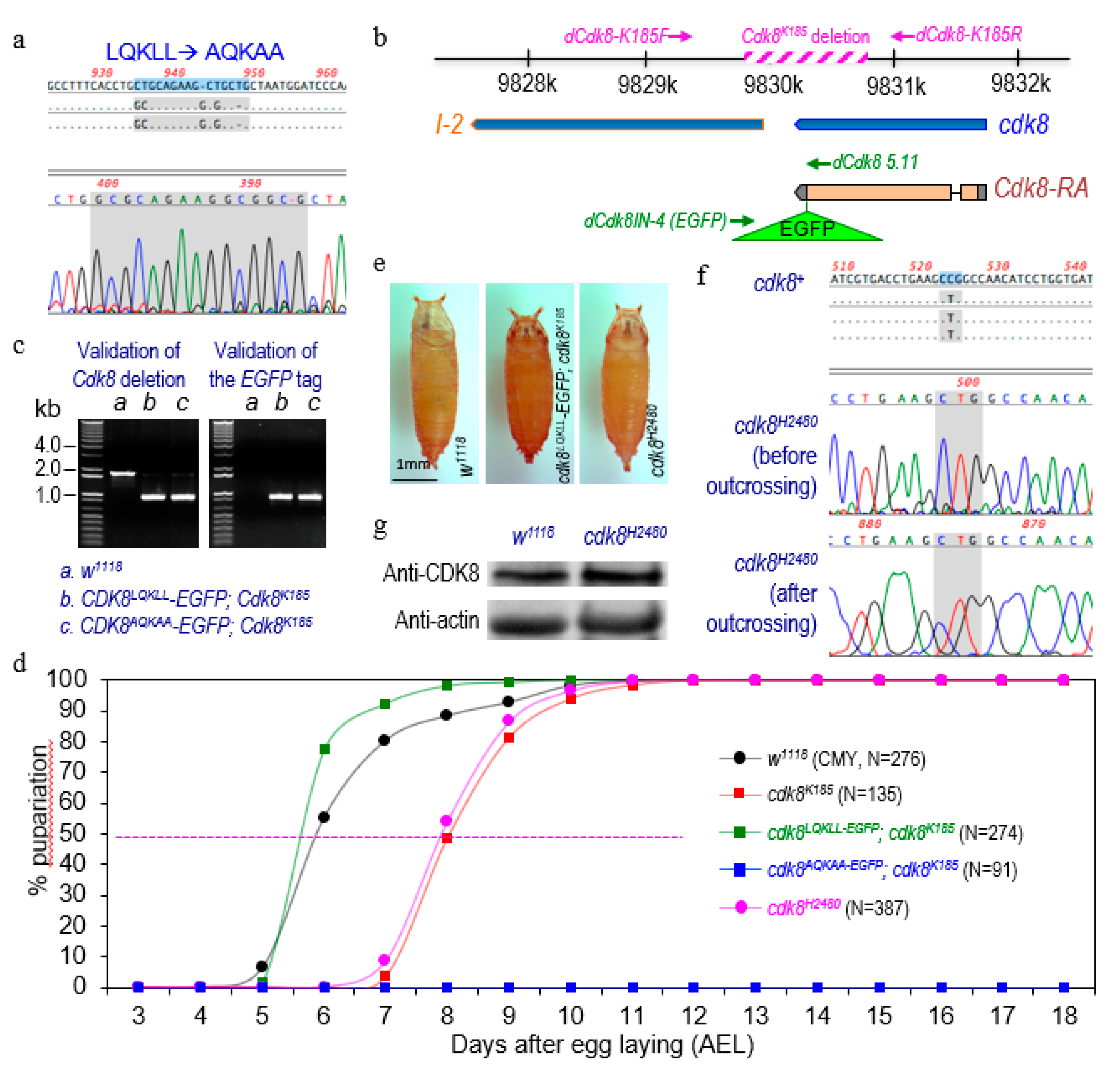

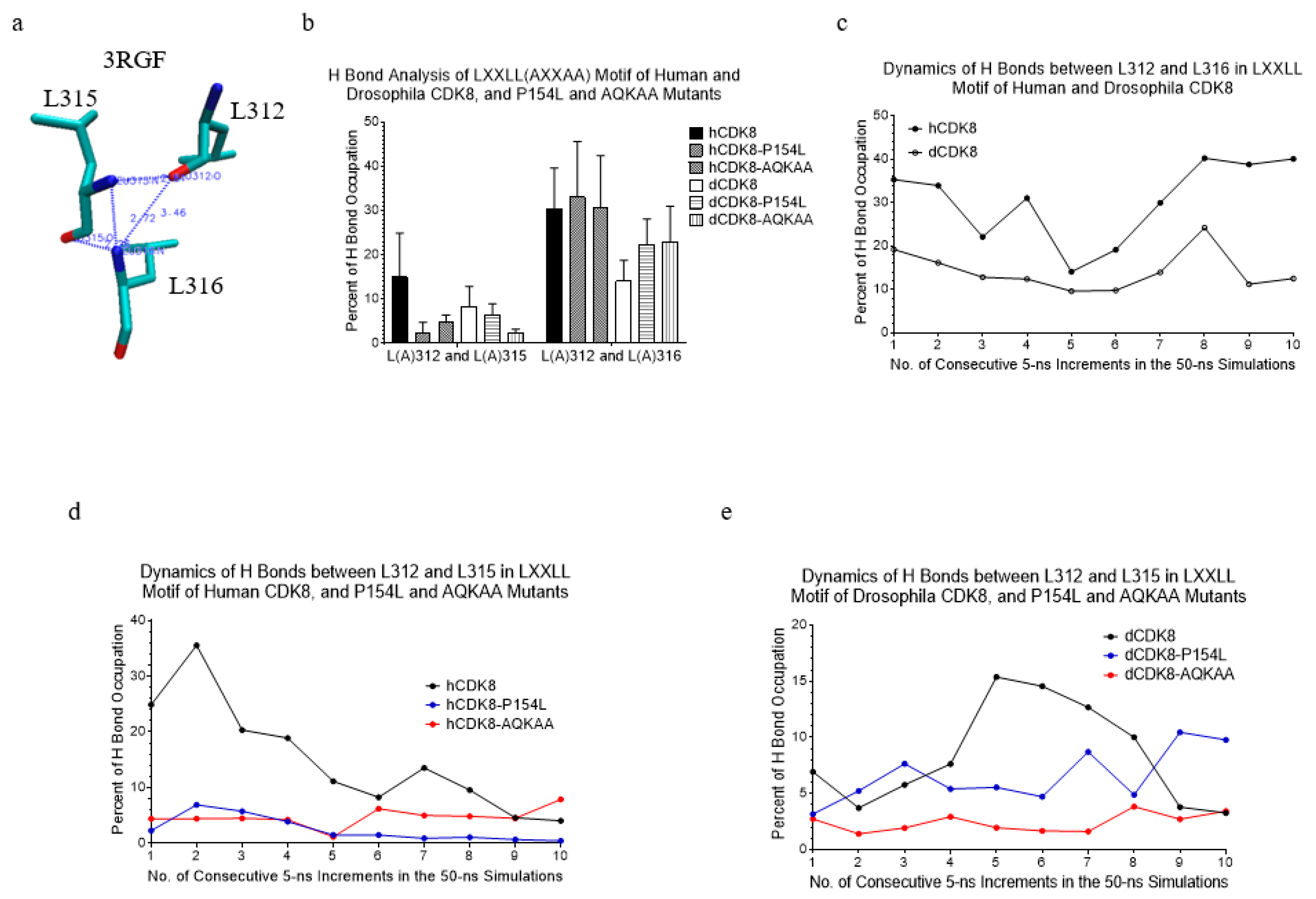
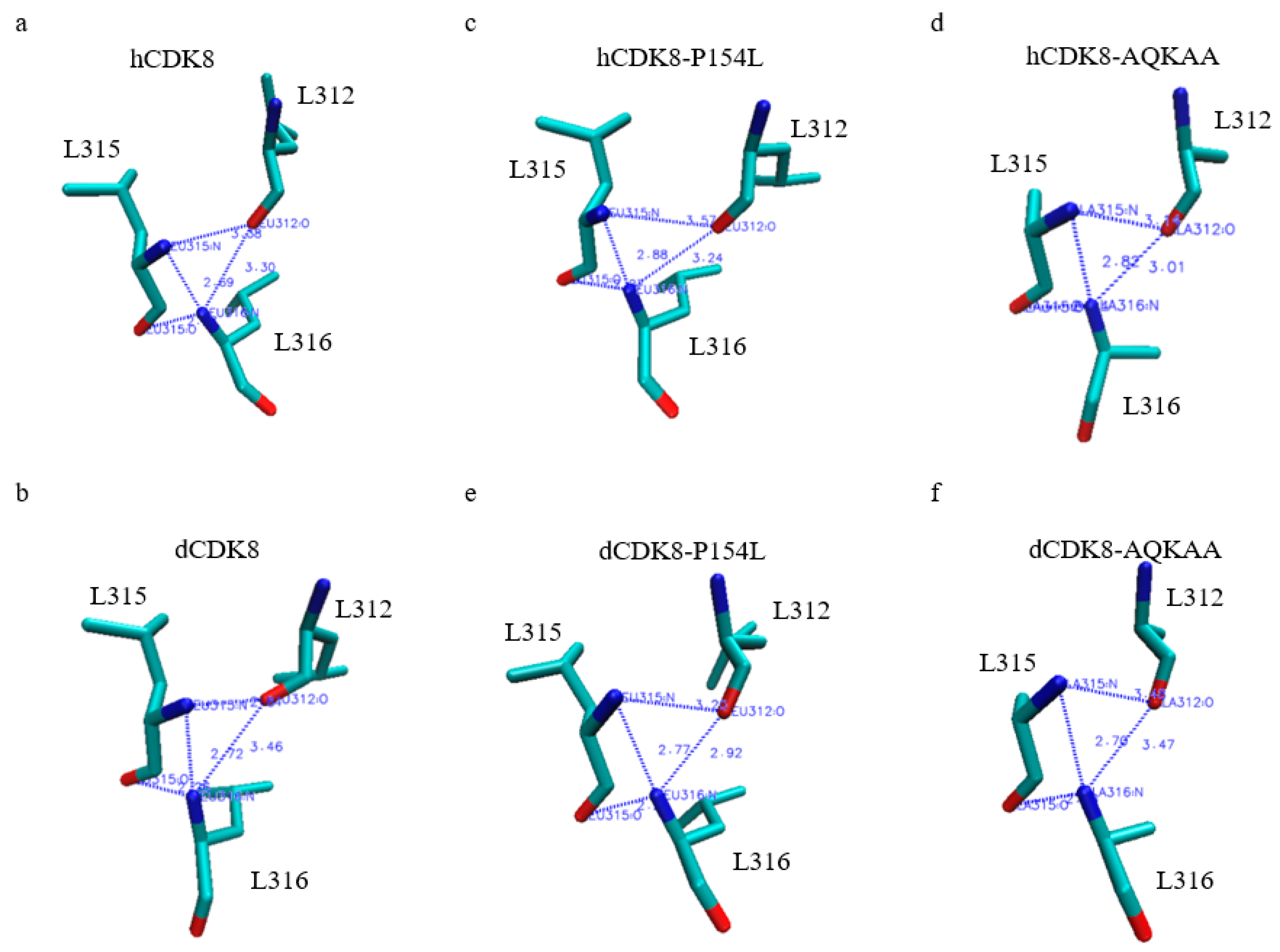
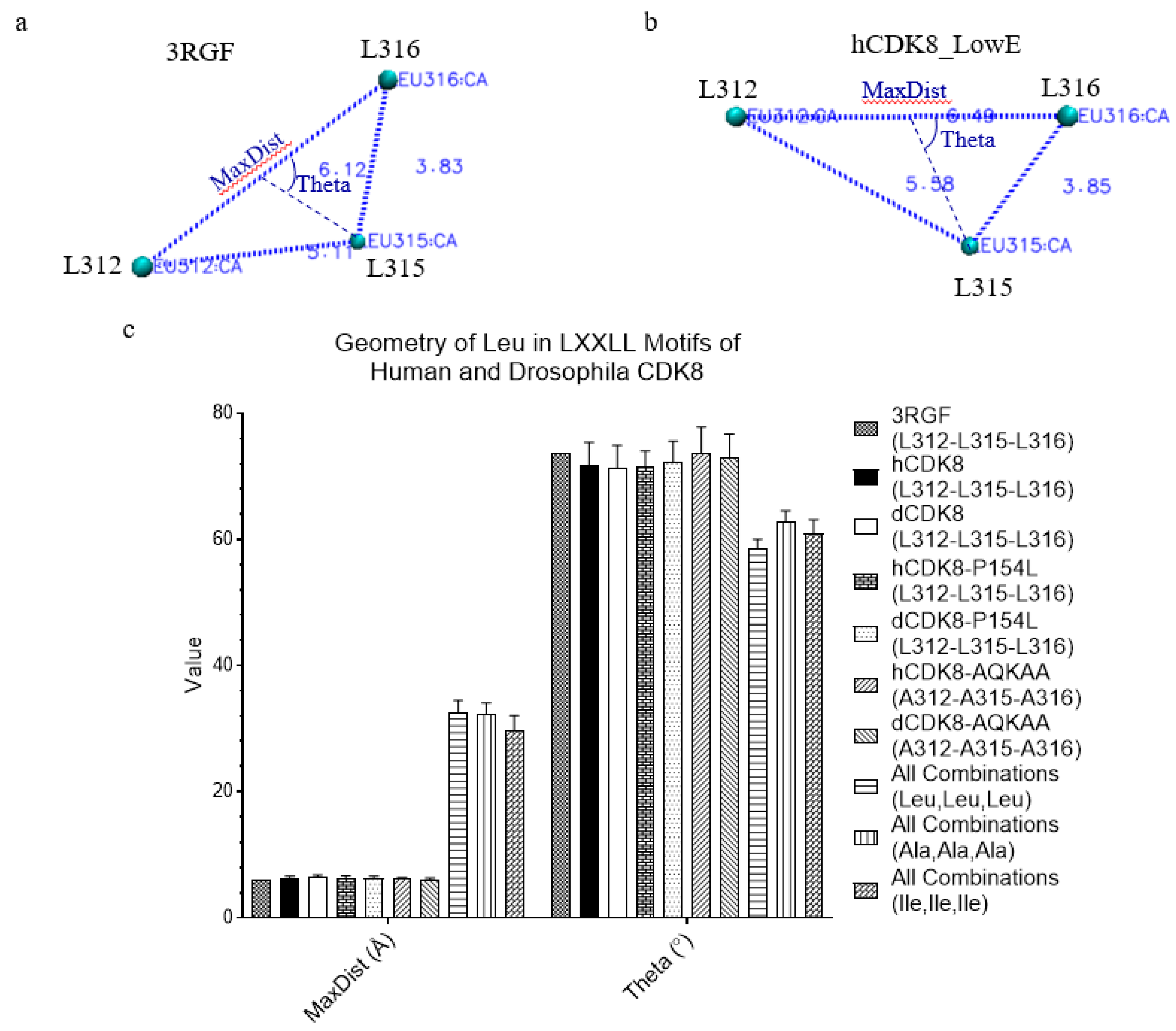
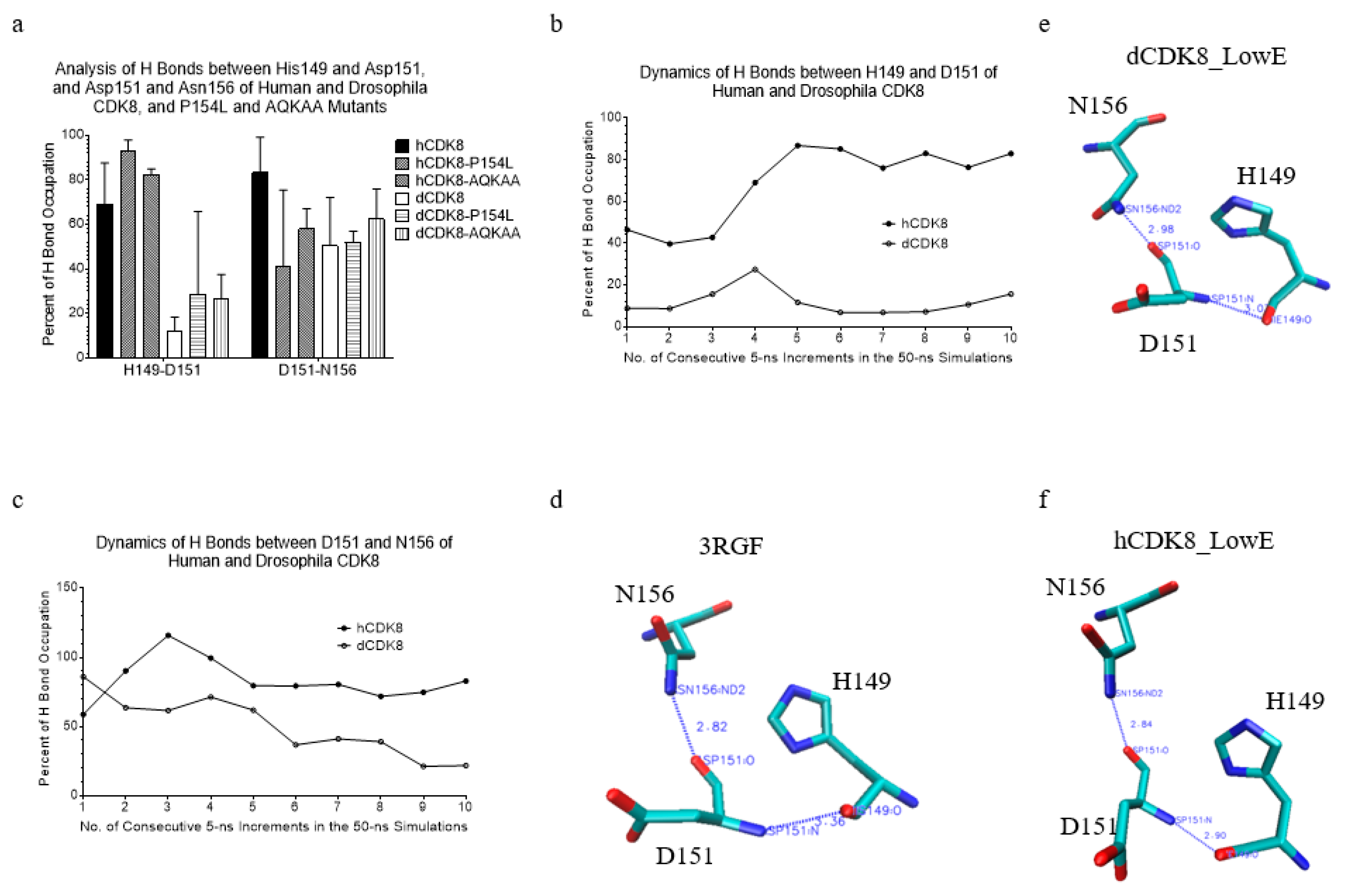
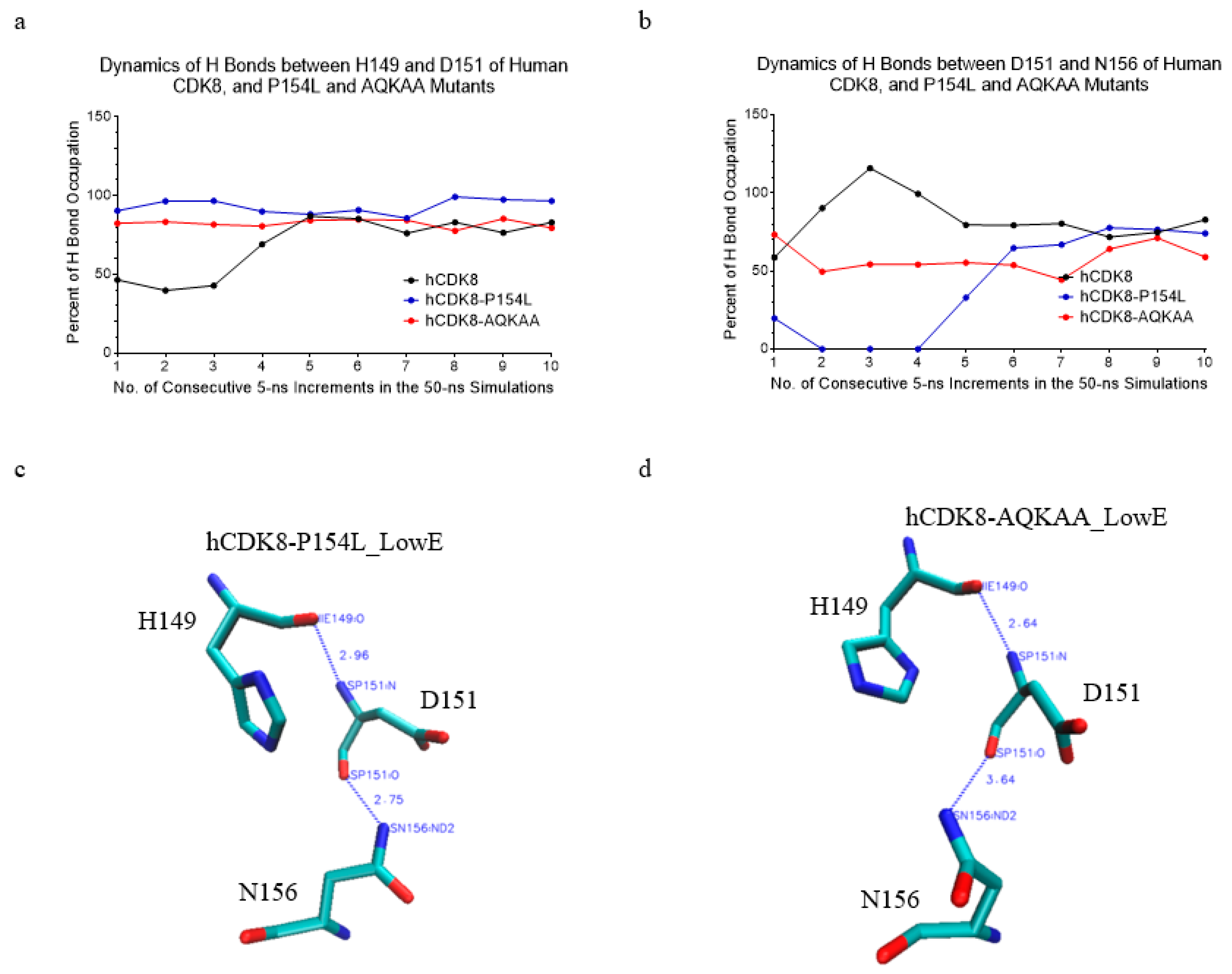
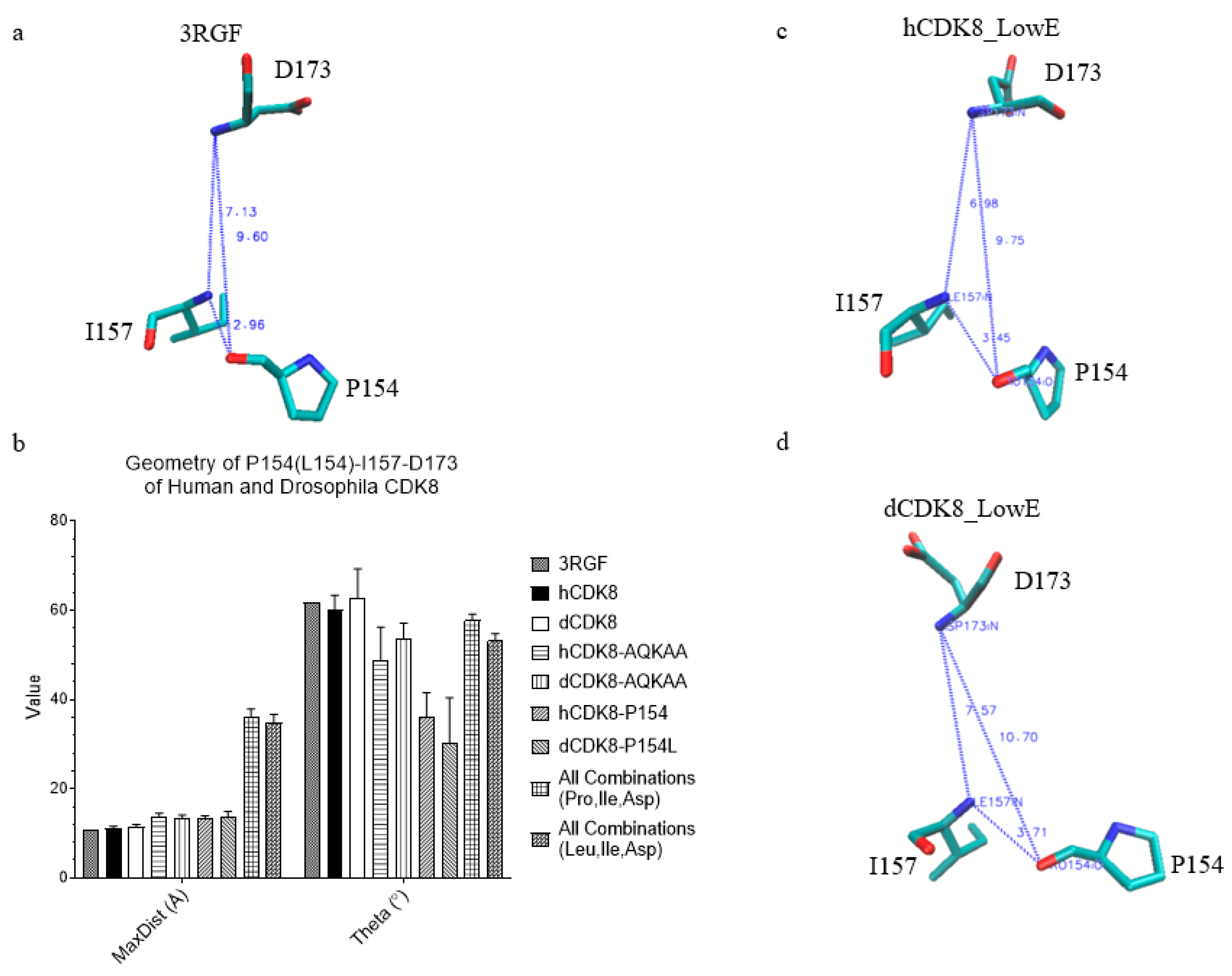

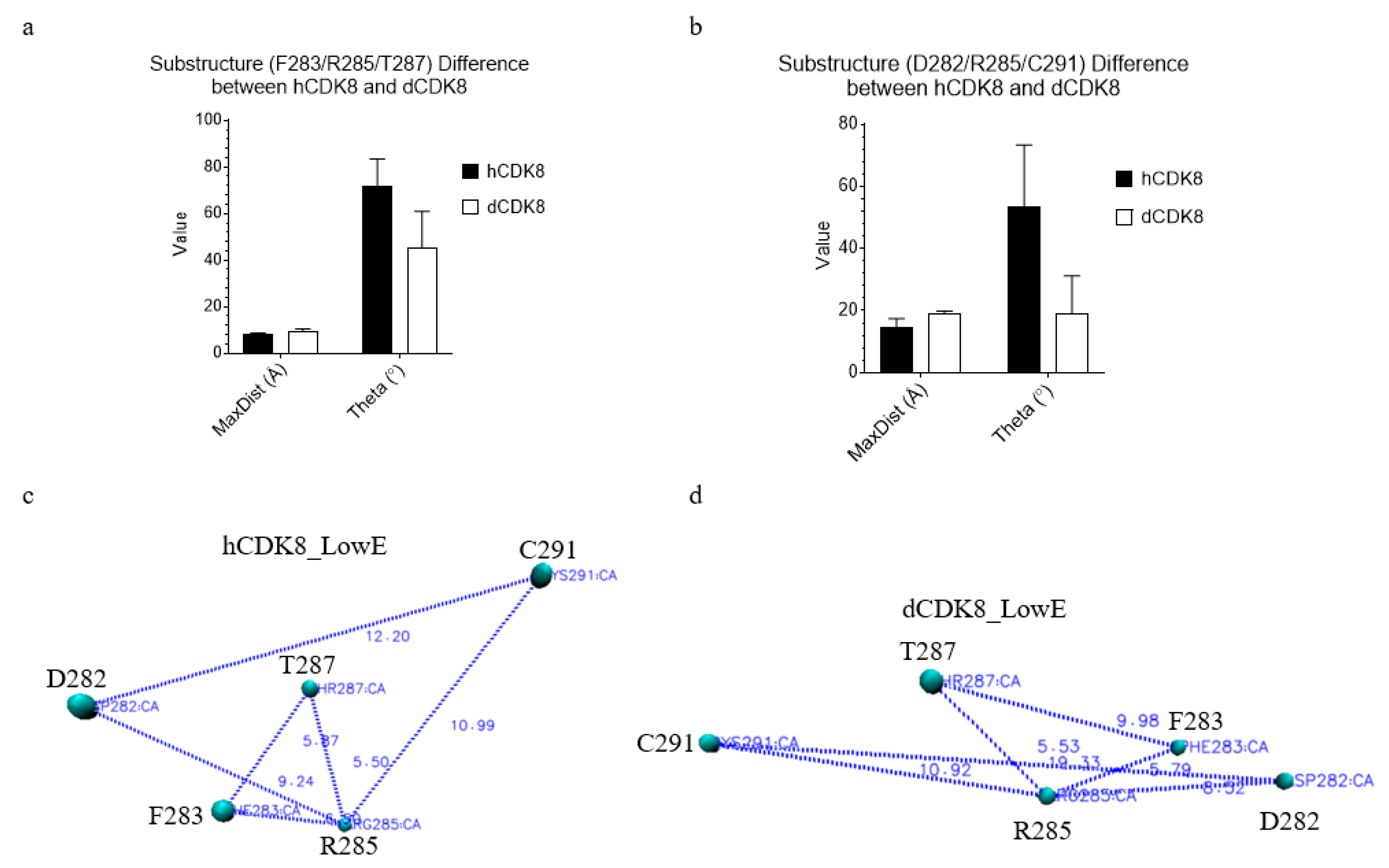
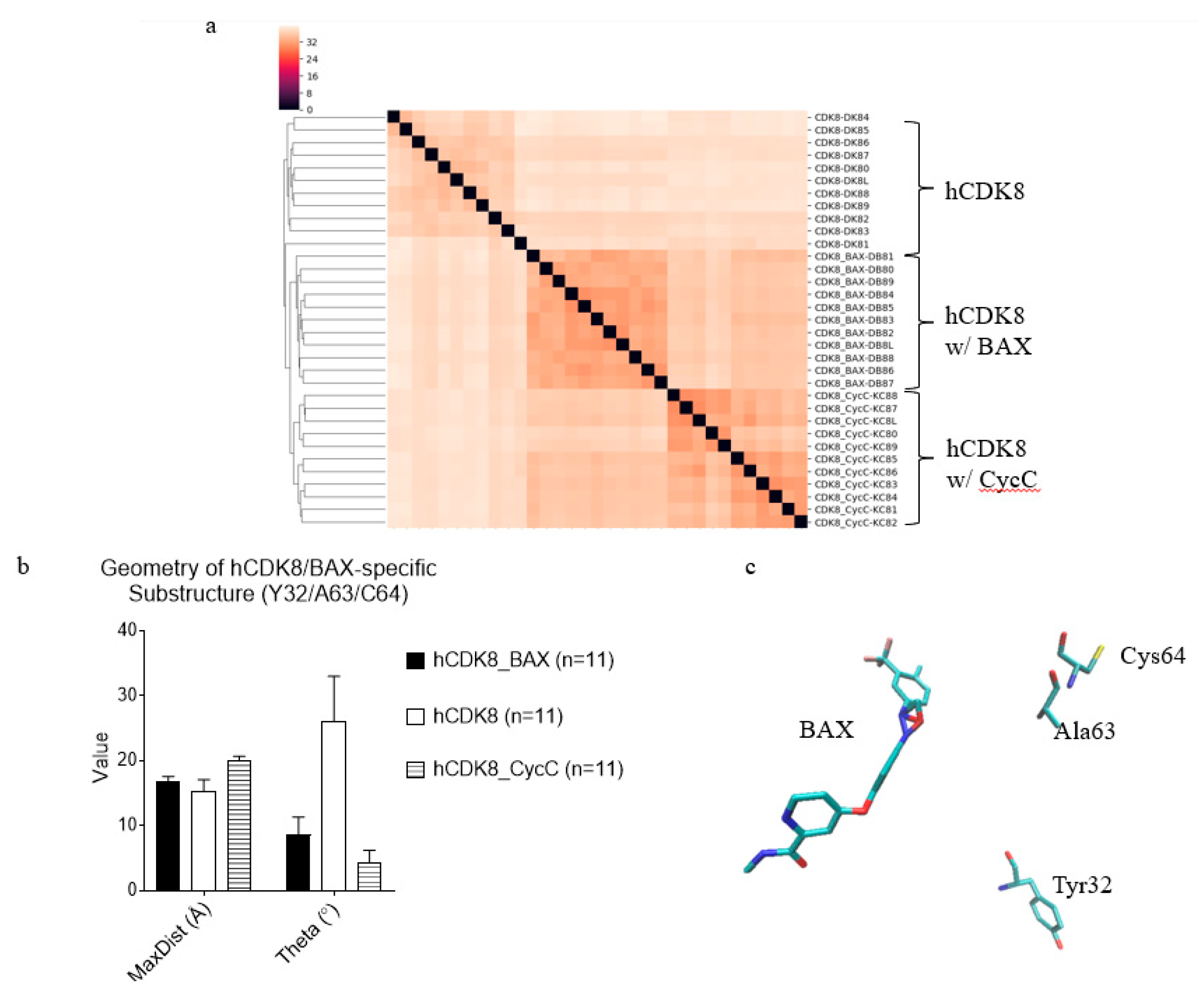


© 2020 by the authors. Licensee MDPI, Basel, Switzerland. This article is an open access article distributed under the terms and conditions of the Creative Commons Attribution (CC BY) license (http://creativecommons.org/licenses/by/4.0/).
Share and Cite
Xu, W.; Xie, X.-J.; Faust, A.K.; Liu, M.; Li, X.; Chen, F.; Naquin, A.A.; Walton, A.C.; Kishbaugh, P.W.; Ji, J.-Y. All-Atomic Molecular Dynamic Studies of Human and Drosophila CDK8: Insights into Their Kinase Domains, the LXXLL Motifs, and Drug Binding Site. Int. J. Mol. Sci. 2020, 21, 7511. https://doi.org/10.3390/ijms21207511
Xu W, Xie X-J, Faust AK, Liu M, Li X, Chen F, Naquin AA, Walton AC, Kishbaugh PW, Ji J-Y. All-Atomic Molecular Dynamic Studies of Human and Drosophila CDK8: Insights into Their Kinase Domains, the LXXLL Motifs, and Drug Binding Site. International Journal of Molecular Sciences. 2020; 21(20):7511. https://doi.org/10.3390/ijms21207511
Chicago/Turabian StyleXu, Wu, Xiao-Jun Xie, Ali K. Faust, Mengmeng Liu, Xiao Li, Feng Chen, Ashlin A. Naquin, Avery C. Walton, Peter W. Kishbaugh, and Jun-Yuan Ji. 2020. "All-Atomic Molecular Dynamic Studies of Human and Drosophila CDK8: Insights into Their Kinase Domains, the LXXLL Motifs, and Drug Binding Site" International Journal of Molecular Sciences 21, no. 20: 7511. https://doi.org/10.3390/ijms21207511
APA StyleXu, W., Xie, X.-J., Faust, A. K., Liu, M., Li, X., Chen, F., Naquin, A. A., Walton, A. C., Kishbaugh, P. W., & Ji, J.-Y. (2020). All-Atomic Molecular Dynamic Studies of Human and Drosophila CDK8: Insights into Their Kinase Domains, the LXXLL Motifs, and Drug Binding Site. International Journal of Molecular Sciences, 21(20), 7511. https://doi.org/10.3390/ijms21207511






